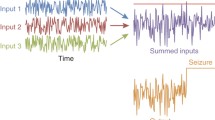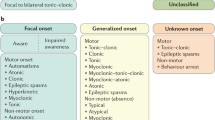Abstract
Epilepsy is a complex disease with diverse clinical characteristics that preclude a singular mechanism. One way to gain insight into potential mechanisms is to reduce the features of epilepsy to its basic components: seizures, epileptogenesis, and the state of recurrent unprovoked seizures that defines epilepsy itself. A common way to explain seizures in a normal individual is that a disruption has occurred in the normal balance of excitation and inhibition. The fact that multiple mechanisms exist is not surprising given the varied ways the normal nervous system controls this balance. In contrast, understanding seizures in the brain of an individual with epilepsy is more difficult because seizures are typically superimposed on an altered nervous system. The different environment includes diverse changes, making mechanistic predictions a challenge. Understanding the mechanisms of seizures in an individual with epilepsy is also more complex than understanding the mechanisms of seizures in a normal individual because epilepsy is not necessarily a static condition but can continue to evolve over the lifespan. Using temporal lobe epilepsy as an example, it is clear that genes, developmental mechanisms, and neuronal plasticity play major roles in creating a state of underlying hyperexcitability. However, the critical control points for the emergence of chronic seizures in temporal lobe epilepsy, as well as their persistence, frequency, and severity, are questions that remain unresolved.
Similar content being viewed by others
References and Recommended Reading
Bouchet C, Cazauvieilh M: De L’epilpsie consideree dans ses raports avec l’alienation mentale. Recherche sur la nature et le siege de ces deux m aladies. Arch Gen Med 1925, 9:510–542.
Sommer W: Erkrankung des Ammonshornes als aetiologisches Moment der Epilepsie. Arch Psychiat Nervendrankh 1880, 10:631–675.
Scharfman HE, Pedley TA: Temporal lobe epilepsy. In The Neurobiology of Disease. Edited by Gilman A. New York: Academic Press; 2006.
Jackson JH: On a particular variety of epilepsy (“intellectual aura”), one case with symptoms of organic brain disease. Brain 1988, 11:179–207.
Jackson JH: Epileptic attacks in a patient who had symptoms pointing to gross organic disease of the right temporo-sphenoidal lobe. Brain 1899, 22:534–549.
Gibbs FA, Gibbs EL, Lennox WG: Epilepsy: a paroxysmal cerebral dysrhythmia. Brain 1937, 60:377–388.
Jasper HH, Pertuiset B, Flanigin H: EEG and cortical electrograms in patients with temporal lobe seizures. Arch Neurol Psychiatry 1951, 65:272–290.
Penfield W, Jasper H: Epilepsy and the Functional Anatomy of the Human Brain. Boston: Little, Brown & Co.; 1954.
Hodgkin AL, Huxley AF: Propagation of electrical signals along giant nerve fibers. Proc R Soc Lond B Biol Sci 1952, 140:177–183.
Hille B: Ion Channels of Excitable Membranes. New York: Sinauer; 2001.
McCormick DA, Huguenard JR: Electrophysiology of the Neuron: An Interactive Tutorial. Oxford: Oxford University Press; 1994.
Somjen GG: Ion regulation in the brain: implications for pathophysiology. Neuroscientist 2002, 8:254–267.
Vaillend C, Mason SE, Cuttle MF, Alger BE: Mechanisms of neuronal hyperexcitability caused by partial inhibition of Na+-K+-ATPases in the rat CA1 hippocampal region. J Neurophysiol 2002, 88:2963–2978.
Grisar T, Guillaume D, Delgado-Escueta AV: Contribution of Na+,K(+)-ATPase to focal epilepsy: a brief review. Epilepsy Res 1992, 12:141–149.
Haglund MM, Stahl WL, Kunkel DD, Schwartzkroin PA: Developmental and regional differences in the localization of Na,K-ATPase activity in the rabbit hippocampus. Brain Res 1985, 343:198–203.
Fukuda A, Prince DA: Postnatal development of electrogenic sodium pump activity in rat hippocampal pyramidal neurons. Brain Res 1992, 65:101–114.
Fellin T, Haydon PG: Do astrocytes contribute to excitation underlying seizures? Trends Mol Med 2005, 11:530–533.
Duffy S, MacVicar BA: Modulation of neuronal excitability by astrocytes. Adv Neurol 1999, 79:573–581.
Meisler MH, Kearney J, Ottman R, Escayg A: Identification of epilepsy genes in human and mouse. Annu Rev Genet 2001, 35:567–588.
Dzhala VI, Talos DM, Sdrulla DA, et al.: NKCC1 transporter facilitates seizures in the developing brain. Nat Med 2005, 11:1205–1213.
Matsumoto R, Ajmone-Marsan C: Cortical cellular phenomena in experimental epilepsy: ictal manifestations. Exp Neurol 1964, 80:305–326.
Brown TH, Johnston D: The synaptic nature of the paroxysmal depolarization shift in hippocampal neurons. Ann Neurol 1984, 16:S65–S71.
Traub RD, Michelson-Law H, Bibbig AE, et al.: Gap junctions, fast oscillations and the initiation of seizures. Adv Exp Med Biol 2004, 548:110–122.
Cobb SR, Buhl EH, Halasy K, et al.: Paulsen O, Somogyi P: Synchronization of neuronal activity in hippocampus by individual GABAergic interneurons. Nature 1996, 378:75–78.
Sloviter RS, Zappone CA, Harvey BD, Frotscher M: Kainic acid-induced recurrent mossy fiber innervation of dentate gyrus inhibitory interneurons: possible anatomical substrate of granule cell hyper-inhibition in chronically epileptic rats. J Comp Neurol 2006, 494:944–960.
Nadler JV: The recurrent mossy fiber pathway of the epileptic brain. Neurochem Res 2003, 28:1649–1658.
Sutula TP, Dudek FE: Unm asking recurrent excitation generated by mossy fiber sprouting in the epileptic dentate gyrus: an emergent property of a complex system. In The Dentate Gyrus: A Comprehensive Guide to Structure, Function, and Clinical Implications. Edited by Scharfman HE. Amsterdam: Elsevier; 2007.
Lewis DV: Losing neurons: selective vulnerability and mesial temporal sclerosis. Epilepsia 2005, 46(Suppl 7):39–44.
Ottman R: Analysis of genetically complex epilepsies. Epilepsia 2005, 46(Suppl 10):7–14.
Lehericy S, Dormont D, Semah F, et al.: Developmental abnormalities of the medial temporal lobe in patients with temporal lobe epilepsy. Am J Neuroradiol 1995, 16:617–626.
Baulac M, DeGrissac M, Hasboun D, et al.: Hippocampal developmental changes in patients with partial epilepsy: magnetic resonance imaging and clinical aspects. Ann Neurol 1998, 44:223–233.
Ho SS, Kuzniecky RI, Gilliam F, et al.: Temporal lobe developmental malform ations and epilepsy: dual pathology and bilateral hippocampal abnormalities. Neurology 1998, 50:748–754.
Meldrum BS: Epileptic brain damage: a consequence and a cause of seizures. Neuropathol Appl Neurobiol 1997, 23:185–201.
Walker MC, White HS, Sander JW: Disease modification in partial epilepsy. Brain 2002, 125:1937–1950.
Riban V, Bouilleret V, Pham-Le BT, et al.: Evolution of hippocampal epileptic activity during the development of hippocampal sclerosis in a mouse model of temporal lobe epilepsy. Neuroscience 2002, 112:101–111.
Scharfman HE, Sollas AL, Smith KL, et al.: Structural and functional asymmetry in the normal and epileptic rat dentate gyrus. J Comp Neurol 2002, 454:424–439.
Bender RA, Dube C, Baram TZ: Febrile seizures and mechanisms of epileptogenesis: insights from an animal model. Adv Exp Med Biol 2004, 548:213–215.
Pitkanen A, McIntosh TK: Animal models of post-traum atic epilepsy. J Neurotrauma 2006, 23:241–261.
Dube C, Vezzani A, Behrens M, et al.: Interleukin-1beta contributes to the generation of experimental febrile seizures. Ann Neurol 2005, 57:152–155.
Lukasiuk K, Pitkanen A: Large-scale analysis of gene expression in epilepsy research: is synthesis already possible? Neurochem Res 2004, 29:1169–1178.
Scharfman HE: Seizure-induced neurogenesis and its dependence on growth factors and cytokines. In Growth Factors and Epilepsy. Edited by Binder DK, Scharfman HE. Hauppague: Nova Sciences; 2005.
Guerrini R, Genton P: Epileptic syndromes and visually induced seizures. Epilepsia 2004, 45(Suppl 1):14–18.
Bazil CW: Sleep disturbances in epilepsy patients. Curr Neurol Neurosci Rep 2005, 5:297–298.
Author information
Authors and Affiliations
Corresponding author
Rights and permissions
About this article
Cite this article
Scharfman, H.E. The neurobiology of epilepsy. Curr Neurol Neurosci Rep 7, 348–354 (2007). https://doi.org/10.1007/s11910-007-0053-z
Published:
Issue Date:
DOI: https://doi.org/10.1007/s11910-007-0053-z




